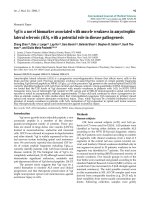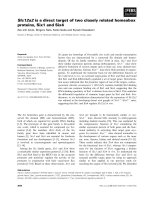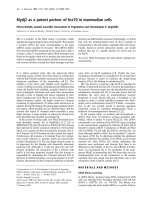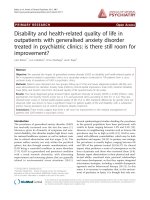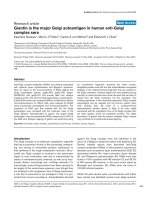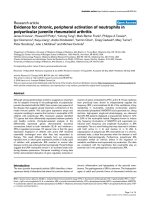Báo cáo y học: "Sepsis is a major determinant of outcome in critically ill HIV/AIDS patients." pdf
Bạn đang xem bản rút gọn của tài liệu. Xem và tải ngay bản đầy đủ của tài liệu tại đây (318.79 KB, 8 trang )
RESEARC H Open Access
Sepsis is a major determinant of outcome in
critically ill HIV/AIDS patients
André M Japiassú
1
, Rodrigo T Amâncio
1
, Emerson C Mesquita
1
, Denise M Medeiros
1
, Helena B Bernal
2
,
Estevão P Nunes
2
, Paula M Luz
2
, Beatriz Grinsztejn
2
, Fernando A Bozza
1*
Abstract
Introduction: New challenges have arisen for the management of critically ill HIV/AIDS patients. Severe sepsis has
emerged as a common cause of intensive care unit (ICU) admission for those living with HIV/AIDS. Contrastingly,
HIV/AIDS patients have been systematically excluded from sepsis studies, limiting the understanding of the impact
of sepsis in this population. We prospectively followed up critically ill HIV/AIDS patients to evaluate the main risk
factors for hospital mortality and the impact of severe sepsis on the short- and long-term survival.
Methods: All consecutive HIV-infected patients admitted to the ICU of an infectious diseases research center, from
June 2006 to May 2008, were included. Severity of illness, time since AIDS diagnosis, CD4 cell count, antiretroviral
treatment, incidence of severe sepsis, and organ dysfunctions were registered. The 28-day, hospital, and 6-month
outcomes were obtained for all patients. Cox proportional hazards regression analysis measured the effect of
potential factors on 28-day and 6-month mortality.
Results: During the 2-year study period, 88 HIV/AIDS critically ill patients were admitted to the ICU. Seventy
percent of patients had opportunist infections, median CD4 count was 75 cells/mm
3
, and 45% were receiving
antiretroviral therapy. Location on a ward before ICU admission, cardiovascular and respiratory dysfunctions on the
first day after admission, and the presence of severe sepsis/septic shock were associated with reduced 28-day and
6-month survival on a univariate analysis. After a multivariate analysis, severe sepsis determined the highest hazard
ratio (HR) for 28-day (adjusted HR, 3.13; 95% CI, 1.21-8.07) and 6-month (adjusted HR, 3.35; 95% CI, 1.42-7.86)
mortality. Severe sepsis occurred in 44 (50%) patients, mainly because of lower respiratory tract infections. The
survival of septic and nonseptic patients was significantly different at 28-day and 6-month follow-up times (log-
rank and Peto test, P < 0.001).
Conclusions: Severe sepsis has emerged as a major cause of admission and mortality for hospitalized HIV/AIDS
patients, significantly affecting short- and longer-term survival of critically ill HIV/AIDS patients.
Introduction
The long-term survival of patients with human immu-
nodeficiency virus (HIV) has markedly improved since
the introduction of highly active antiretroviral therapy
(HAART). UNAIDS/WHO estimated at 33.4 million the
number of people living with HIV in December 2008
[1]. It is expected that this number will continue to
grow, in particular in third-world urban centers. Recent
studies have analyzed HIV/AIDS critically ill patients ’
characteristics, especially comparing pre- and post-
HAART eras, with emphasis on causes of admission and
risk factors for mortality [2-7]. A large cohort of HIV
critically ill patients showed that sepsis is among the
causes of ICU admissions with increasing incidence,
contrary to the decreasing trend observed for acute
respiratory insufficiency and Pneumoc ystis jiroveci pneu-
monia [8]. Other studies have shown that bacterial
infection is becoming increasingly prevalent in patients
with HIV admitted to the ICU, irrespective o f HAART
use [9-11]. However, severe sepsis has not been system-
atically studied with respect to its prevalence during the
ICU stay, microbiologic and organ-dysfunction charac-
teristics, and impact on the outcome.
* Correspondence:
1
Intensive Care Unit, Instituto de Pesquisa Clínica Evandro Chagas, Fundação
Oswaldo Cruz, Av Brasil 4365, Rio de Janeiro, RJ, 21040-360, Brazil
Full list of author information is available at the end of the article
Japiassú et al. Critical Care 2010, 14:R152
/>© 2010 Japiassú et al; licensee BioMed Central Ltd. This is an open access article dis tributed unde r the terms of the Creative Commons
Attribution License ( s/by/2.0), which permits unrestricte d use, distributio n, and reproduction in
any medium, provided the original work is properly cited.
Epidemiologic studies have shown t hat a fraction of
1% to 10% of the sepsis patients are composed of indivi-
duals with HIV/AIDS, according to regional differences
in the prevalence of HIV infection and ICU a dmission
practices [12-19]. Recently, analysis of a large United
States database of septic hospitalized patients showed
that the septic HIV patients have lower rates of ICU
admission compared with non-HIV groups [20].
Despite the significant increases in survival and quality
of life, HIV/AIDS patients have been systematically
exclud ed from sepsis studies, limiting the understanding
of the impact of sepsis in this population. To date, few
studies have assessed prospectively the determina nts of
survival of critically ill HIV/AIDS patients.
In this study, we prospectively followed up HIV/AIDS
critically ill patients to evaluate the key factors related
to outcome, with emphasis on impact of severe sepsis
on the short- and long-term survival.
Materials and methods
Design and setting
This prospective cohort study was conducted at the ICU
of the Instituto de Pesquisa Clínica Evandro Chagas
(IPEC), Fundação Oswaldo Cruz, Rio de Janeiro, Brazil.
IPEC has provided care to HIV/A IDS patients in Rio de
Janeiro since 1986 and, currently, more than 2,000 adult
patients are actively followed up at the HIV/AIDS clinic.
At our institution, only patients for whom potentially
lifespan-extending treatment is available are usually con-
sidered for ICU admission. Critically ill unstable patients
with indications for intensive care and monitoring and/
or need f or immediate procedures or interventions are
eligible for ICU admission. Treatment-limitation deci-
sions are taken when patients do not recover from acute
illness despite intensive care, or when control of the
baseline condition has not been achieved. These deci-
sions are shared by the ICU team, HIV/AIDS specialist,
and family members, based on local practices [21].
The study was supported by institutional f unds. The
institutional review board approved the study and
waived the need for informed consent. The conduct of
the study did not interfere with patient-management
decisions.
Participants, data collection, and definitions
All consecutive HIV-infected patients admitted to the
ICUfromJune2006toMay2008wereincludedinthis
study. AIDS cases and the occurrence of AIDS-defining
diseases were set by the Centers for Disease Control
and Prevention (CDC) definitions, and HAART was
initiated when the CD4 cell count was below 200-
350 cells/mm
3
[22]. Time since AIDS diagnosis was cal-
culated from AIDS onset until ICU admission. Recent
AIDSonsetwasdefinedasthatoccurring2monthsor
less before admission. The CD4 cell count was consid-
ered when obtained within 3 months of ICU admission
or measured during the first week of ICU entry.
HAART was defined as the regular use of at least two
nucleoside reverse transcriptase inhibitors (NRTI) plus a
protease inhibitor (PI) or a nonnucleoside reverse tran-
scriptase inhibitor (NNRTI) or a PI and an NNRTI in
combination [20]. As adherence is a major component
on HIV treatment efficacy, it is always checked and
noted on the patient’s medical charts at our institution.
In case of multiple ICU admissions, only the first on e
was considered. ICU causes of admission were divided
into acute respiratory insufficiency, sepsis, severe neuro-
logic disturbances, heart disease, complications of solid
organ or hematologic neoplasia, metabolic disturbance,
and gastrointestinal complications. Readmissions were
defined for patients returning to the ICU during the
same hospitalization.
A standardized data-entry form was created for the
collection of demographic data, main admission diagno-
sis, opportunistic infections, comorbidities, location
before ICU admission (emergency room, ward, or other
hospital), laboratory results based on computerized
laboratory records review, ICU, and hospital length of
stay. The follow ing variables were collected during the
first day of the ICU stay: expanded Simplified Acute
Physiology Score (SAPS) II [23,24], Sequential Organ
Failure Assessment (SOF A) score [25], and use of vaso-
pressor agents. Performance Status (PS) was calculat ed
based on patient or surrogate information [26]. During
the ICU stay, the need for mechanical ventilation for
more than 24 hours, use of renal-support devices, devel-
opment of shock (use of vasopressor agent to maintain
mean arterial pressure higher than 70 mm Hg) and
acute lung injury (defined as PaO
2
/FiO
2
ratio less than
300) were also recorded.
Sepsis definitions were based on the ACCP/SCCM
Consensus Conference [27]; sepsis was present if there
was a presumed or confirmed infection, associated with
at least two of the following: tachycardia >90 beats/min;
tachypnea >30 cycles/min (or hypocapnia <32 mm Hg);
fever (>38°C) or hypothermia ( <36°C); and leukocytosis
(>12,000/mm
3
) or leukop enia (<4,000/mm
3
)orthepre-
sence of more than 10% immature forms. Severe sepsis
was defined if any organ dysfunction, sepsis-induced
hypotension, or elevated serum lactate levels were pre-
sent. Septic shock was defined as sepsis with hypoten-
sion that persisted after adequate infusion of fluids and
the need for vasopressor agents.
Infections were classified as community acquired or
nosocomial, according to the cutoff time point 48 h of
hospital admission. Definitions of lower pulmonary tract
infection, bloodstream infection, and urinary tract infec-
tion were made by following the CDC definitions [28].
Japiassú et al. Critical Care 2010, 14:R152
/>Page 2 of 8
Appropriate biologic material was sampled from sus-
pected sites of infection. Microbiologic data were col-
lected and analyzed according to the local Infection
Control Committee.
Statistical analysis
Continuous variables were summarized as medians and
interquartile ranges. We compared the distribution of
continuous variables by using the t test, and of categoric
variables by using the c
2
test. We calculated the Kaplan-
Meier survival function stratified by sepsis. The log-rank
and Peto tests were used to evaluate whether the esti-
mated survival functions were significantly different by
strata. Two ou tcomes were of interest: mortality within
28 days and 6 mon ths from entry to the ICU. We used
Cox proportional hazards regression analysis to measure
the effect of sepsis, as well as other factors, on 28-day
and 6-month mortality. We also e stimated the effect of
sepsis while controlling for potential confounders such
as age, time since AIDS diagnosis, HAART, location
before ICU, and cardiovascular and respiratory dysfunc-
tions, in a multivariate model. The CD4 cell count was
not included on the multivariate model because of the
heterogeneity of the period of data collection (within 3
months of ICU admission or during the first week of
ICU entry). The proportionality assumption in Cox’s
regression was evaluated by the estimating the correla-
tion between survival time and Shoen feld’s standardized
residuals. We used the s tatistical software R, version 2.9
[29] for all statistical analysis.
Results
Patient characteristics
During the 2-year study period, 437 HIV-positive
patients were admitted to the hospital, and 101 patients
became critically ill. However, 13 patients were not con-
sidered for life-sustaining measures and died in the hos-
pital ward. One hundred seven ICU admissions of 88
patients were recorded. We analyzed only t he first ICU
admission of each of these 88 patients; their characteris-
tics are shown in Table 1. In brief, the median age was
40 years, with a male predominance (76%). The median
CD4 cell count was 75 ( interquartile range, 32 to 227)
cells/mm
3
. The median time since AIDS diagnosis was
40 months. Twenty-five patients (28%) had recently
been diagnosed with AIDS; 40 patients (45%) were
adherent to HAART, and the remaining 27% had irregu-
lar use of HAART. The percentage of patients using the
three drug classes was as follows: NRTI (97%), PI (67%),
and NNRTI (35%). HAART use did not affect hospital
survival (50% mortality for HAART and non-HAART
subjects). Patients not using HAART were younger (37
versus 43 years; P = 0.03), had more opportunistic
infections (83% versus 55%; P < 0.01), and had less time
since AIDS diagnosis (3.5 versus 68.5 months; P < 0.01).
Acute respiratory failure was the cause of ICU admis-
sion for 29% of the p atients, caused by bacterial pneu-
monia (n = 10), Pneumocystis jiroveci pneumonia (n =
8), tuberculosis (n = 6), and cardiogenic pulmonary
edema (n = 2). Severe neurologic complications were
the cause of ICU admission in 20 patients (23%), and
severe sepsis was present in 18 patients (20%). Other
causes of ICU admission were decompensated heart dis-
ease (n = 9), gastrointestinal complications (n =6),
metabolic dysfunction secondary to renal dysfunc tion or
lactic acidosis related to drug adverse effects (n =5),
and complications of high-grade non-Hodgkin lym-
phoma (n = 4) (Table 1). Sixty-two patients (70%) had
at least one opportunistic infection; P. jiroveci pneumo-
nia and neurotoxoplasmosis were the most frequent
opportunistic infections.
In-hospital mortality
The observed in-hospital mortality during t he s tudy per-
iod was 49%. We compared the characteristics of patients
who survived until the hospital discharge with those of
patients who did not. Patients with non-Hodg kin lym-
phoma and gastrointestinal complications had a worse
outcome (mortality, 100% and 83%, respectively), whereas
patients initially seen with acute respiratory failure, neu-
rologic disorders, and sepsis had moderate mortality
rates (46%, 45%, and 50%, respectively). SAPS II (54 ver-
sus 44 points; P < 0.001) and SOFA score on day 1 (7 ver-
sus 4 points, P < 0.001) were significantly higher for
nonsurvivors (Table 2). Early shock (use of vasopressor
Table 1 Demographics, HIV/AIDS characteristics, and
causes of admission to ICU of all patients
Patients (n = 88)
Age (years) 40 (31-47)
Male gender 67 (76%)
Time since AIDS diagnosis (months) 40 (2-90)
Recent AIDS diagnosis 25 (28%)
CD4 cell count (per mm
3
) 75 (32-227)
HAART use 40 (45%)
Cause of admission
Acute respiratory failure 26 (29%)
Coma/torpor 20 (23%)
Sepsis 18 (20%)
Decompensated heart disease 9 (10%)
Gastrointestinal diseases 6 (7%)
Metabolic disturbance 5 (6%)
High-grade lymphoma 4 (5%)
Continuous values are shown as median and interquartile interval. AIDS,
acquired immunodeficiency syndrome; ICU, intensive care unit; HAART, highly
active antiretroviral therapy.
Japiassú et al. Critical Care 2010, 14:R152
/>Page 3 of 8
agents in the first 24 h since admission) was more com-
mon in nonsurvivors (30% versus 13%; P < 0.05). Nonsur-
vivors used more life-support devices, such as mechanical
ventilation (84% versus 38%; P < 0.01) and renal support
therapy (30% versus 7%; P < 0.01). Severe sepsi s or septic
shock was observed with higher frequency for the non-
survivor group (67% versus 33%; P < 0.01). Other demo-
graphic characteristics such as age, gender, admission
from emergency or ward, and Performance Status were
similar in the two groups. No statistical difference was
noted betwee n the two groups regarding CD4 cell count,
time since AIDS diagnosis, and HAART use.
Severe sepsis in HIV/AIDS patients
Forty-four patients (50%) had severe sepsis at ICU
admission or during the ICU stay. In comparison with
nonsepsis patients, sepsis patients were more likely to
come from wards (75% versus 45%; P <0.01),spent
more time in the ICU (11 versus 7 days; P = 0.03), were
more severely ill (SAPS II, 56 versus 44 points; P <
0.001; had SOFA on day 1, 7 versus 3 points; P < 0.001),
and needed mechanical ventilation more often (86% ver-
sus 34%; P < 0.001). We did not observe differences in
CD4 cell count or time since AIDS diagnosis between
septic and nonseptic groups. Hospital mortality was sig-
nificantly higher in septic when compared to nonseptic
patients (66% versus 34%; P = 0.002). Lung was the
most common s ite of infection (52%), followed by pri-
mary bloodstream infections (38%), venous catheter-
related bacteremia (7%), and urinary tract infections
(3%) (Table 3). Nosocomial infections were the source
of sepsis in 90% of the cases in our cohort. Microbiology
of infections was mostly composed of gram-negative
rods, such as Pseudomonas aeruginosa (10), Klebsiella
pneumoniae (six), Enterobacter sp. (five), Escherichia coli
(three), Acinetobacter sp. (three), Serratia marcescens
(three), and Staphylococcus sp. (nine). Mycobacterium
tuberculosis was the etiologic agent of severe sepsis in
six (14%) patients. There were also single cases of
S. maltophilia, C. difficile, C. freundi, B. cepacia,and
Candida sp. Bacteremia was detected in 43% (19) of the
sepsis patients, irrespectively of the site of infection.
The 28-day and 6-month survival
By using Cox proportional hazard s regression, we esti-
mated that the hazard of death at 28 days for sepsis
patients was 4 times higher than that for nonsepsis
patients (HR, 4.17; 95% CI, 1.96 to 8.90). Other factors
associated with an increased hazard of death at 28 days
were being in a hospital ward before entry to the ICU, and
cardiovascular and respiratory dysfunctions (Table 4). The
effect of sepsis on 28-day mortality was even stronger in
the multivariate model, when controlling for confounding
factors. The adjusted hazard o f d eath at 28 days was
almost threefold higher (HR, 3.13; 95% CI, 1.21 to 8.07)
for sepsis patients compared with nonsepsis patients when
controlling for age, time since AIDS diagnosis, HAART,
location before ICU, an d cardiov ascular and re spirator y
dysfunctions. When considering 6-months of follow-up,
sepsis also determined the highest hazard of death in both
the crude (HR, 3.25; 95% CI, 1.75 to 6.16) and adjusted
(HR, 3.35; 95% CI, 1.42 to 7.86) analysis (T able 4). Th e
survival e xpectati on of sepsis and n onsepsis patients was
Table 2 Comparison of patients according to hospital
survival
Survivors
(n = 45)
Nonsurvivors
(n = 43)
Age (mean ± SD) 42 (35-50) 38 (29-46)
Male gender (%) 36 (80%) 31 (72%)
Location before ICU (ward, %) 24 (53%) 29 (67%)
Performance status 3 or 4 1 (0-2) 2 (1-3)
CD4 count <50 mm
3
(%) 20 (44%) 21 (49%)
Length of time from AIDS diagnosis 39 (2-92) 50 (2-85)
Recent (<3 months) AIDS diagnosis 13 (29%) 13 (30%)
HAART use 20 (44%) 20 (46%)
SAPS II expanded (points) 44 (37-54) 54 (46-67)
b
SOFA D1 (points) 4 (1-7) 7 (4-10)
b
Mechanical ventilation 17 (38%) 36 (84%)
b
Use of vasopressors on day 1 6 (13%) 15 (30%)
a
Renal support 3 (7%) 13 (30%)
b
Severe sepsis/septic shock (%) 15 (33%) 29 (67%)
b
ICU length of stay (days) 9 (5-17) 10 (4-14)
Hospital length of stay (days) 24 (12-58) 15 (10-24)
a
AIDS, acquired immunodeficiency syndrome; ICU, Intensive Care Unit; HAART,
highly active anti-retroviral Therapy; SAPS, Simplified Acute Physiology Score;
SOFA, Sequential Organ Failure Assessment. Significant differences are shown
as
a
P <0.05;
b
P <0.01.
Table 3 Site of infection and microbiologic data of septic
shock AIDS patients
Site of infection n
Pulmonary 23 (52%)
Primary bacteremia 17 (38%)
Venous catheter-related infection 3 (7%)
Urinary tract infections 1 (3%)
Microbiology of infection N
Pseudomonas aeruginosa 10 (23%)
Klebsiella pneumoniae 6 (13%)
Mycobacterium tuberculosis 6 (13%)
Enterobacter sp. 5 (11%)
Staphylococcus aureus 5 (11%)
Staphylococcus negative-coagulase 4 (9%)
Escherichia coli 3 (7%)
Acinetobacter calcoaceticus 3 (7%)
Serratia marcescens 3 (7%)
Other 5 (11%)
Japiassú et al. Critical Care 2010, 14:R152
/>Page 4 of 8
significantly different both at 28-day and 6-month follow-
up time points (Figure 1, P values for log-rank and Peto
tests <0.001) (Figure 1). No significant difference of 28-day
or 6-month mortality was retrieved when on-admission or
ICU-acquired severe sepsis was analyzed separately. When
comparing follow-up periods, we noticed that, although
the effect of sepsis was stronger during 28-day follow-up,
it remained significant at 6 months.
Discussion
The improvement of HIV/AIDS management has led to
changes in the observed clinical manifestations and out-
comes of these patients in critical care units, with a
decreasing trend in admissions due to opportunistic
infections, whereas an opposing trend has been observed
for other inf ectious and metabolic disea ses [30]. Severe
sepsis has emerged as a common cause of hospital
admission for those living with HIV/AIDS [2,8,31]. In
this prospective study, we demonstrated that severe sep-
sis is the main risk factor for hospital mortality in a
cohort of HIV/AIDS critically ill patients.
Sepsis-related mortality was increased in both short-
and longer-term follow-up. Indeed, sepsis patients had
significantly higher in-hospital mortality than did non-
sepsis patients. Severe sepsis was strongly associated
with worse outcomes and was caused by bact erial infec-
tions, mainly of nosocomial origin. Nosocomial infec-
tions appear to be more common in patients w ith
acquired AIDS compared with those not HIV infected
[32]. Nosocomial infections have been associated with
immunosuppression level, prior ant ibiotic use, and
greater exposure to invasive devices such as intravenous
catheters [33]. The CD4 cell count in our cohort was
very low, and this could be associated with greater use
of antibiotics for opportunistic infections prophylaxis or
for treatment of bacterial infections contributing to a
high rate of antibiotic resistance and, consequently, the
development of nosocomial infection.
Table 4 Crude and adjusted hazard ratios (HRs) and 95% confidence intervals for factors associated with 28-day and
6-month mortality, as estimated by using Cox proportional hazards regression
28-Day mortality 6-Month mortality
Crude HR
(95% CI)
Adjusted HR (95% CI) Crude HR
(95% CI)
Adjusted HR (95% CI)
Age (<40 years) 1.96
(0.99-3.89)
1.52
(0.84-2.77)
Location before ICU (ward) 2.28
a
(1.10-4.73)
1.93
a
(1.02-3.64)
Cardiovascular dysfunction 2.97
a
(1.23-7.13)
2.12
a
(1.05-4.30)
Respiratory dysfunction 2.21
a
(1.01-4.86)
1.58
(0.82-3.02)
Severe sepsis/Septic shock 4.17
b
(1.96-8.90)
3.13
b
(1.21-8.07)
3.25
b
(1.75-6.16)
3.35
b
(1.42-7.86)
Time since AIDS diagnosis (<60 days) 0.96
(0.46-2.00)
0.95
(0.49-1.84)
HAART 1.31
(0.68-2.52)
1.21
(0.67-2.18)
AIDS, acquired immunodeficiency syndrome; ICU, Intensive Care Unit; HAART, highly active anti-retroviral therapy. Significant differences are shown as
a
P < 0.05;
b
P < 0.01. Adjusted HR includes adjustments for age, CD4 count, time since AIDS diagnosis, HAART, location before ICU, and cardiovascular and respiratory
dysfunctions.
Figure 1 Kaplan-Meier plot of survival up to 28 days (top) and
6 months (bottom) of sepsis and nonsepsis AIDS patients
admitted to ICU.
Japiassú et al. Critical Care 2010, 14:R152
/>Page 5 of 8
Pneumonia and bloodstream infections were the main
sites of infections for almost all sepsis patients, and hos-
pital-acquired bacteria composed the major part of the
microbiology of severe infections. Lower-tract respira-
tory infection was also the main site of infection in two
other studies [34,35]. Additionally, a high incidence of
nosocomial bacteremia occurred in our cohort (43%).
Bloodstream infections can negatively affect HIV/AIDS
patients’ outcomes [33,36-39]. In general, the microbiol-
ogy of the HIV/AIDS sepsis patients was similar to that
reported in non-HIV-infect ed patients. We observed a
predominance of gram-negative and gram-positive bac-
teria, but also Mycobacterium tuberculosis,whichwas
the main pathogen associated with severe sepsis in five
of 44 patients. Tuberculosis, which is highly prevalent in
developing countries, has been found to cause bactere-
mia in AIDS patients [36,40-44].
The development of organ dysfunctions was analyzed
as a possible contribution to hospital mortality. In our
study, cardiovascular and respiratory dysfunctions
increased the hazards of death, especially in the short
term. Respiratory dysfunction is closely associated to
mechanical ventilation use and the presence of severe
sepsis. Cardiovascular dysfunction could also be related
to the presence of shock and the use of vasoactive
agents, which a re more frequent in s epsis patients. Use
of mechanical ventilation [3,5,31,45,46], higher APACHE
II or SAPS II scores [2,31,45,46], use of HAART during
the ICU stay [45], and opportunistic infections [3,5,46]
have been found to affect hospital mortality in a hetero-
geneous group of studies. Low CD4 cell counts, time
since AIDS diagnosis, HAART treatment, or AIDS stage
of disease, conversely, were not ident ified as risk factors
for mortality in the post-HAART era [4,6,46].
In our cohort, almost 30% of patients had a recent
AIDS diagnosis and were HAART naive, and an addi-
tional 16% of the patients were noncompliant HAART
users. We found that these groups, who correspond to
almost 50% of the patients in our study, were not sub-
ject to higher hospital mortality. Recent data has shown
a greater impact of ICU care rat her than HIV/AIDS
management as major risk factors for death. Ventilat ory
management with lower tidal volumes was shown to be
protective against mortalit y due to acute lung injury in
critically ill HIV patients [47].
Themaincontributionofourstudyreliesonthefact
that sepsis is the most important risk factor for mortality
in patients with HIV/AIDS admitted to the ICU. O ther
studies have not evaluated the diagnosis of severe sepsis
or septic shock as an independent variable on survival
analysis, whereas they gave greater e mphasis to the pre-
sence of opportunistic infections or immunosuppression
surrogates (CD4 cell count or viral load). Additionally, it
provides new information on the microbiology of sepsis
of the HIV/AIDS population, highlighting the occurrence
of nosocomial severe infections and the great impact of
sepsis on 1- and 6-month survival; second, confirming
that CD4 the T-cell count, the HIV RNA level, and other
HIV/AIDS variables were not predictive of 30-day and 6-
month outcomes.
Otherwise, our s tudy has limitations. The study was
conducted in a single center specializing in HIV/AIDS
patients care, lessening a greater generalizability; and a
multicenter study is needed to confirm our findings
regarding the effects of severe sepsis on HIV/AIDS criti-
cally ill patients. Although no prospective comparison
was made with a cohort without HIV, similarities exist
in the micr obiology of infections and incidence of organ
dysfunctions with the non-HIV/AIDS population
reported in the literature [20,48,49]. Future studies are
necessary to evaluate the long-term effects of sepsis on
quality of life and on functional capacity.
Finally, although international efforts sought to reduce
sepsis mortality, increased survival has not been
observed in low- and middle-income c ountries (LMICs)
[18,50-53]. New strategies to reduce the impact of sep-
sis, especially in LMICs, are timely. Those strategies
should be able to deal with specific subgroups of
patients, including the HIV/AIDS population. In this
setting, the prevention of both nosocomial and commu-
nity-acquired infections should be incorporated into
sepsis guidelines as a cost-effective measure for LMICs.
Conclusions
We demonstrated that severe sepsis is the main risk fac-
tor for hospital mortality in our cohort, significantly
affecting short- and longer-term survival of HIV/AIDS
critically ill patients. Mortality was shown to be more
dependent on critically illness factors such as the pre-
sence of sepsis and the severity of organ dysfunction
than on the H IV/AIDS-related characteristics, such as
the level of immunodeficiency, use of HAART, or time
since AIDS diagnosis. A high level of suspicion related
to sepsis diagnosis coupled with initiatives related to
nosocomial infection and sepsis prevention could contri-
bute to decrease mortality in critically ill HIV/AIDS
patients.
Key messages
• Sepsis is the most important risk factor for mortal-
ity in HIV/AIDS patients admitted to ICUs, affecting
short- and longer-term survival. HIV/AIDS variables,
such as CD4 T-cell count and HIV RNA level, play
a secondary role for the prognosis of critically ill
HIV/AIDS patients.
• A high level of suspicion related to sepsis diagnosis
coupled with initiatives related to nosocomial
Japiassú et al. Critical Care 2010, 14:R152
/>Page 6 of 8
infection and sepsis prevention could contribute to
decrease mortality in critically ill HIV/AIDS patients.
Abbreviations
ACCP/SCCM: American College of Chest Physicians/Society of Critica l Care
Medicine; APACHE: Acute Physiology and Chronic Health Evaluation Score;
CD4: cluster of differentiation 4; HAART: Highly Active Antiretroviral Therapy;
HIV/AIDS: human immunodeficiency virus/acquired immunodeficiency
syndrome; ICU: intensive care unit; NNRTI: nonnucleoside reverse
transcriptase inhibitor; NRTI: nucleoside reverse transcriptase inhibitor; PI:
protease inhibitor; PS: performance status; SAPS: Simplified Acute Physiology
Score; SOFA: Sequential Organ Failure Assessment.
Acknowledgements
FAB and BG are research scholars from CNPq and FAPERJ. The authors thank
Dr. Valdiléa Veloso (Instituto de Pesquisa Clínica Evandro Chagas, Rio de
Janeiro, Brazil) for the institutional support.
Author details
1
Intensive Care Unit, Instituto de Pesquisa Clínica Evandro Chagas, Fundação
Oswaldo Cruz, Av Brasil 4365, Rio de Janeiro, RJ, 21040-360, Brazil.
2
HIV/AIDS
Research Centre, Instituto de Pesquisa Clínica Evandro Chagas, Fundação
Oswaldo Cruz, Av Brasil 4365, Rio de Janeiro, RJ, 21040-360, Brazil.
Authors’ contributions
All authors made substantial contribution to the study design and methods.
AMJ, DMM, and FAB conceived of the study. AMJ, RTA, ECM, and HBB
collected clinical and microbiologic data. PML performed the data analysis.
AMJ, PML, and FAB drafted the manuscript, and DMM, EPN, and BG critically
revised it for important intellectual content. All authors read and approved
the final version of the manuscript.
Competing interests
The authors declare that they have no competing interests.
Received: 2 February 2010 Revised: 9 April 2010
Accepted: 10 August 2010 Published: 10 August 2010
References
1. UNAIDS/WHO: AIDS Epidemic Update 2009.[ />Report/2009/2009_epidemic_update_en.pdf].
2. Afessa B, Green B: Clinical course, prognostic factors, and outcome
prediction for HIV patients in the ICU: The PIP (Pulmonary
Complications, ICU Support, and Prognostic Factors in Hospitalized
Patients with HIV) Study. Chest 2000, 118:138-145.
3. Morris A, Creasman J, Turner J, Luce JM, Watcher RM, Huang L: Intensive
care of human immunodeficiency virus-infected patients during the era
of highly active antiretroviral therapy. Am J Respir Crit Care Med 2002,
166:262-267.
4. Narasihman M, Posner AJ, DePalo VA, Mayo PH, Rosen MJ: Intensive care in
patients with HIV infection in the era of highly active antiretroviral
therapy. Chest 2004, 125:1800-1804.
5. Khouli H, Afrasiabi A, Shibli M, Hajal R, Barrett CR, Homel P: Outcome of
critically ill human immunodeficiency virus-infected patients in the era
of highly active antiretroviral therapy. J Intensive Care Med 2005,
20:327-333.
6. Palacios R, Hidalgo A, Reina C, de la Torre MV, Márquez M, Santos J: Effect
of antiretroviral therapy on admissions of HIV-infected patients to an
intensive care unit. HIV Med 2006, 7:193-196.
7. Powell K, Davis JL, Morris AM, Chi A, Bensley MR, Huang L: Survival for
patients with HIV admitted to the ICU continues to improve in the
current era of combination antiretroviral therapy. Chest 2009, 135:11-17.
8. Huang L, Quartin A, Jones D, Havlir DV: Intensive care of patients with HIV
infection. N Engl J Med 2006, 355:173-181.
9. Rosen MJ, Narasimhan M: Critical care of immunocompromised patients:
human immunodeficiency virus. Crit Care Med 2006, 34:S245-S250.
10. Davaro RE, Thirumalai A: Life-threatening complications of HIV infection. J
Intensive Care Med 2007, 22:73-81.
11. Grinsztejn B, Veloso VG, Friedman RK, Moreira RI, Luz PM, Campos DP,
Pilotto JH, Cardoso SW, Keruly JC, Moore RD: Early mortality and cause of
deaths in patients using HAART in Brazil and the United States. AIDS
2009, 23:2107-2114.
12. Angus DC, Linde-Zwirble WT, Lidicker J, Clermont G, Carcillo J, Pinsky MR:
Epidemiology of severe sepsis in the United States: analysis of
incidence, outcome, and associated costs of care. Crit Care Med 2001,
29:1303-1310.
13. Martin GS, Mannino DM, Eaton S, Moss M: The epidemiology of sepsis in
the United States from 1979 through 2000. N Engl J Med 2003,
348:1546-1554.
14. Annane D, Aegerter P, Jars-Guincestre MC, Guidet B: Current epidemiology
of septic shock. Am J Resp Crit Care Med 2003, 168:165-172.
15. The EPISEPSIS Study Group: EPISEPSIS: a reappraisal of the epidemiology
and outcome of severe sepsis in French intensive care units. Intensive
Care Med 2004, 30:580-588.
16. Ballester JCA, Ballester F, Sánchez AG, Quilis AA, Rubio EC, Otero CP:
Epidemiology of sepsis in the valencian community (Spain), 1995-2004.
Infect Control Hosp Epidemiol 2008, 29:630-634.
17. Blanco J, Muriel-Bombín A, Sagredo V, Taboada F, Gandía F, Tamayo L,
Collado J, García-Labattut A, Carriedo D, Valledor M, De Frutos M, López MJ,
Caballero A, Guerra J, Alvarez B, Mayo A, Villar J, Grupo de Estudios y
Análisis en Cuidados Intensivos: Incidence, organ dysfunction and
mortality in severe sepsis: a Spanish multicentre study. Crit Care 2008, 12:
R158.
18. Khwannimit B, Bhurayanontachai R: The epidemiology of, and risk factors
for, mortality from severe sepsis and septic shock in a tertiary-care
university hospital setting. Epidemiol Infect 2009, 137:1333-1341.
19. Beale R, Reinhart K, Brunkhorst FM, Dobb G, Levy M, Martin G, Martin C,
Ramsey G, Silva E, Vallet B, Vincent JL, Janes JM, Sarwat S, Williams MD,
PROGRESS Advisory Board: Promoting Global Research Excellence in
Severe Sepsis (PROGRESS): lessons from an international sepsis registry.
Infection 2009, 37:222-232.
20. Mrus JM, Braun LA, Yi MS, Linde-Zwirble WT, Johnston JA: Impact of HIV/
AIDS on care and outcomes of severe sepsis. Crit Care 2005, 9:R623-R630.
21. Soares M, Terzi RGG, Piva JP: End-of-life care in Brazil. Intensive Care Med
2007, 33:1014-1017.
22. Centers for Disease Control and Prevention (CDC): Impact of the expanded
AIDS surveillance case definition on AIDS case reporting–United States,
first quarter, 1993. MMWR Morb Mortal Wkly Rep 1993, 42:308-311.
23. Le Gall JR, Lemeshow S, Saulnier F: A new Simplified Acute Physiologic
Score (SAPS II) based on an European/North American multicenter
study. JAMA 1993, 270:2957-2963.
24. Le Gall JR, Neumann A, Hemery F, Bleriot JP, Fulgencio JP, Garrigues B,
Gouzes C, Lepage E, Moine P, Villers D: Mortality prediction using SAPS II:
an update for French intensive care units. Crit Care 2005, 9:R645-R652.
25. Vincent JL, Moreno R, Takala J, Willatts S, de Mendonça A, Bruining H,
Reinhart CK, Suter PM, Thijs LG: The SOFA (Sepsis-related Organ Failure
Assessment) score to describe organ dysfunction/failure. Intensive Care
Med 1996, 22:707-710.
26. Zubrod CG, Schneiderman M, Frei E III: Appraisal of methods for the study
of chemotherapy of cancer in man: comparative therapeutic trial of
nitrogen mustard and triethylene thiophosphoramide. J Chron Dis 1960,
11:7-33.
27. Bone RC, Balk RA, Cerra FB, Dellinger RP, Fein AM, Knaus WA, Schein RM,
Sibbald WJ: Definitions for sepsis and organ failure and guidelines for
the use of innovative therapies in sepsis: the ACCP/SCCM Consensus
Conference Committee, American College of Chest Physicians/Society of
Critical Care Medicine. Chest 1992, 101:1644-1655.
28. Horan TC, Andrus M, Dudeck MA: CDC/NHSN surveillance definition of
health care-associated infection and criteria for specific types of
infections in the acute care setting. Am J Infect Control
2008, 36:309-332.
29. R Project. [].
30. Pacheco AG, Tuboi SH, May SB, Moreira LFS, Ramadas L, Nunes EP,
Merçon M, Faulhaber JC, Harrison LH, Schechter M: Temporal changes in
causes of death among HIV-infected patients in the HAART era in Rio de
Janeiro, Brazil. J Acquir Immune Defic Syndr 2009, 51:624-630.
31. Casalino E, Wolff M, Ravaud P, Choquet C, Bruneel F, Regnier B: Impact of
HAART advent on admission patterns and survival in HIV-infected
patients admitted to an intensive care unit. AIDS 2004, 18:1429-1433.
Japiassú et al. Critical Care 2010, 14:R152
/>Page 7 of 8
32. Angus DC, Wax RS: Epidemiology of sepsis: an update. Crit Care Med 2001,
29:S109-S116.
33. Petrosillo N, Pagani L, Ippolito G, Gruppo HIV e Infezioni Ospedaliere:
Nosocomial infections in HIV-positive patients: an overview. Infection
2003, , Suppl 2: 28-34.
34. Thyrault M, Gachot B, Chastang C, Souweine B, Timsit JF, Bédos JP,
Regnier B, Wolff M: Septic shock in patients with the acquired
immunodeficiency syndrome. Intensive Care Med 1997, 23:1018-1023.
35. Rosenberg AL, Seneff MG, Atiyeh L, Wagner R, Bojanowski L,
Zimmerman JE: The importance of bacterial sepsis in intensive care unit
patients with acquired immunodeficiency syndrome: implications for
future care in the age of increasing antiretroviral resistance. Crit Care
Med 2001, 29:548-556.
36. Arthur G, Nduba VN, Kariuki SM, Kimari J, Bhatt SM, Gilks CF: Trends in
bloodstream infections among human immunodeficiency virus-infected
adults admitted to a hospital in Nairobi, Kenya, during the last decade.
Clin Infect Dis 2001, 33:248-256.
37. Hung CC, Hsueh PR, Hsieh SM, Liu CJ, Chen MY, Luh KT: Bacteremia and
fungemia in patients with advanced human immunodeficiency vírus
(HIV) infection in Taiwan. J Formos Med Assoc 1998, 97:690-697.
38. Tumbarello M, Tacconelli E, Donati KG, Citton R, Leone F, Spanu T, Cauda R:
HIV-associated bacteremia: how it has changed in the highly active
antiretroviral therapy (HAART) era. J Acquir Immune Defic Syndr 2000,
23:145-151.
39. Vidal F, Mensa J, Martínez JA, Almela M, Marco F, Gatell JM, Richart C,
Soriano E, Jiménez de Anta MT: Pseudomonas aeruginosa bacteremia in
patients infected with human immunodeficiency virus type 1. Eur J Clin
Microbiol Infect Dis 1999, 18:473-477.
40. Grinsztejn B, Veloso VG, Pilotto JH, Campos DP, Keruly JC, Moore RD:
Comparison of clinical response to initial highly active antiretroviral
therapy in the patients in clinical care in the United States and Brazil. J
Acquir Immune Defic Syndr 2007, 45:515-520.
41. Schmaltz CA, Santanna FM, Neves SC, Velasque LD, Lourenço MC,
Morgado MG, Rolla VC, Lopes GS: Influence of HIV infection on mortality
in a cohort of patients treated for tuberculosis in the context of wide
access to HAART, in Rio de Janeiro, Brazil. J Acquir Immune Defic Syndr
2009, 52:623-628.
42. Pacheco AG, Durovni B, Cavalcante SC, Lauria LM, Moore RD, Moulton LH,
Chaisson RE, Golub JE: AIDS-related tuberculosis in Rio de Janeiro, Brazil.
PLoS One 2008, 3:e3132.
43. Waddell RD, Lishimpia K, von Reyn CF, Chintua C, Babooa KS, Kreiswirthb B,
Talbotc EA, Karagas MR: Study Group: bacteremia due to Mycobacterium
tuberculosis or M. bovis, Bacille Calmette-Guerin (BCG) among HIV positive
children and adults in Zambia. AIDS 2001, 15:55-60.
44. Grinsztejn B, Fandinho FC, Veloso VG, João EC, Lourenço MC, Nogueira SA,
Fonseca LS, Werneck-Barroso E:
Mycobacteremia in patients with the
acquired immunodeficiency syndrome. Arch Intern Med 1997,
157:2359-2363.
45. Croda J, Croda MG, Neves A, Santos SS: Benefit of antiretroviral therapy
on survival of human immunodeficiency virus-infected patients
admitted to an intensive care unit. Crit Care Med 2009, 37:1605-1611.
46. Vincent B, Timsit JF, Auburtin M, Schortgen F, Bouadma L, Wolff M,
Regnier B: Characteristics and outcomes of HIV-infected patients in the
ICU: impact of the highly active antiretroviral treatment era. Intensive
Care Med 2004, 30:859-866.
47. Davis JL, Morris A, Kallet RH, Powell K, Chi AS, Bensley M, Luce JM, Huang L:
Low tidal volume ventilation is associated with reduced mortality in
HIV-infected patients with acute lung injury. Thorax 2008, 63:988-993.
48. Silva E, Pedro Mde A, Sogayar AC, Mohovic T, Silva CL, Janiszewski M,
Cal RG, de Sousa EF, Abe TP, de Andrade J, de Matos JD, Rezende E,
Assunção M, Avezum A, Rocha PC, de Matos GF, Bento AM, Corrêa AD,
Vieira PC, Knobel E, Brazilian Sepsis Epidemiological Study: Brazilian Sepsis
Epidemiological Study (BASES study). Crit Care 2004, 8:R251-R260.
49. Sales-Júnior JA, David CM, Hatum R, Souza PC, Japiassú A, Pinheiro CT,
Friedman G, Silva OB, Dias MD, Koterba E, Dias FS, Piras C, Luiz RR: An
epidemiological study of sepsis in intensive care units. Sepsis Brazil
Study. Rev Bras Ter Intens 2006, 18:9-17.
50. Dellinger RP, Levy MM, Carlet JM, Bion J, Parker MM, Jaeschke R, Reinhart K,
Angus DC, Brun-Buisson C, Beale R, Calandra T, Dhainaut JF, Gerlach H,
Harvey M, Marini JJ, Marshall J, Ranieri M, Ramsay G, Sevransky J,
Thompson BT, Townsend S, Vender JS, Zimmerman JL, Vincent JL,
International Surviving Sepsis Campaign Guidelines Committee; American
Association of Critical-Care Nurses; American College of Chest Physicians;
American College of Emergency Physicians; Canadian Critical Care Society;
European Society of Clinical Microbiology and Infectious Diseases, et al:
Surviving Sepsis Campaign: international guidelines for management of
severe sepsis and septic shock: 2008. Crit Care Med 2008, 36:296-327.
51. Becker JU, Theodosis C, Jacob ST, Wira CR, Groce NE: Surviving sepsis in
low-income and middle-income countries: new directions for care and
research. Lancet Infect Dis 2009, 9:577-582.
52. Cheng AC, West TE, Limmathurotsakul D, Peacock SJ: Strategies to reduce
mortality from bacterial sepsis in adults in developing countries. PLoS
Med 2008, 5:e175.
53. Bozza FA, Salluh JI: An urban perspective on sepsis in developing
countries. Lancet Infect Dis 2010, 10:290-291.
doi:10.1186/cc9221
Cite this article as: Japiassú et al.: Sepsis is a major determinant of
outcome in critically ill HIV/AIDS patients. Critical Care 2010 14:R152.
Submit your next manuscript to BioMed Central
and take full advantage of:
• Convenient online submission
• Thorough peer review
• No space constraints or color figure charges
• Immediate publication on acceptance
• Inclusion in PubMed, CAS, Scopus and Google Scholar
• Research which is freely available for redistribution
Submit your manuscript at
www.biomedcentral.com/submit
Japiassú et al. Critical Care 2010, 14:R152
/>Page 8 of 8
